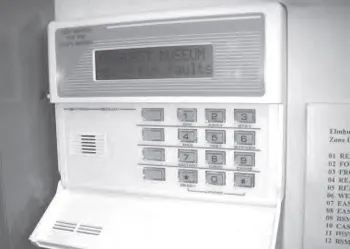![]()
1 ENTERING THE OFFICE
A FEW YEARS AGO I was dropping off a proposal at Paul Allen’s office. I knew it was unlikely that I would see him, but I was looking forward to seeing what the (outer) office of one of the world’s richest men looked like.
I walked down the corridor and was 20 feet from his office door when a voice greeted me. The voice was from somewhere above or behind me; I couldn’t tell where.
“Can I help you?” asked the faceless voice.
Not sure who was talking or who the voice was talking to, I continued toward the door. But then the voice repeated itself.
I looked around again and not seeing anyone, mumbled, “I have a package to drop off.”
“Deliver it to room 200, down the hall and one floor down,” directed the voice.
Not only was I prevented from seeing the great man, I couldn’t even see his office or the person behind the mysterious voice. I couldn’t get in the front door.
Just getting into an office today involves technology that didn’t exist a few years ago. Of course some technology, such as keys and mechanical locks, has been around for centuries. But parking lot magnetic card readers and remote control door openers are fairly new. They provide a high level of security and certainly a dose of awe.
If you’re able to get into the office, another layer of technology awaits you. An emergency enunciator mounted in a wall is ready to tell incoming fire and rescue workers where the trouble is. A time clock may be ready to tell your boss where you are . . . or where you aren’t. Security control boxes and keypads allow you to enter your office and punch in a code to keep the alarms from going off. Automatic door closers and exit lights help keep us safe.
So don’t just walk into an office; play the sleuth. Take another look at the stuff in plain sight that you’ve seen hundreds of times before not knowing what it is or what it does. Then search this chapter to find the answers.
Garage Door Opener Touch Pad
BEHAVIOR
Allows you to open a parking gate or garage door without a handheld remote control unit kept in your car. System managers can change the code to keep out people who no longer warrant access.
HABITAT
Touch pads are mounted on metal poles or stands immediately in front of the gate, so you and only you can drive in when the gate opens. The same type of device is used outside office doors to keep people out of restricted areas.
HOW IT WORKS
When you punch in your code, it is recognized by a logic circuit in the garage door electronics and opens the door. The motor that opens the door is started by the adjacent circuit. Typically the door or gate closes after a fixed time period.
For vertical doors, the motor doesn’t lift the entire weight of the door, which can be enormous. Springs counterbalance the door’s weight, so the motor does less work. In sliding gates, the weight is supported by wheels that run on rails or on the ground.
INTERESTING FACTS
Some systems allow managers to record entry into the garage or lot, so they can tell who is on the premises at any time.
Parking Lot Sensor
BEHAVIOR
Opens the gate or door so you can leave the garage or lot.
HABITAT
The sensor is installed in the ground in front of the exit lift gate or door, or installed two car lengths in front of the gate.
HOW IT WORKS
Some garages require you to use the same remote control to leave that you used to enter. However, most employ some type of sensor to detect the presence of a car or motorcycle (but probably not a bicycle—you’re out of luck unless the garage provides a manual push button).
One approach to opening the gate is to bury a coil of wire in the ground and run an electric current through the coil. The coil generates an electromagnetic field. When a car drives on top of the coil, it changes the magnetic field and the change is detected by a sensor. The exit door or gate system continuously checks the sensor to see if the field has been changed. When the sensor “sees” the car (a changed magnetic field), the system starts the motors that raise or move the gate.
Some systems use an infrared beam to detect cars. You can see the beam transmitter off to the side of the gate or door. It has an eye-like device that allows infrared radiation to pass. It may have a second eyelike glass cover where the beam, reflected from a silvered device on the opposite side of the driveway, bounces back to it. This two-eyed system is less expensive because it doesn’t require installation of a sensor on the other side of the driveway.
In the alternative system, the detector is located on the other side of the driveway. Cars waiting to leave block the beam to trigger the gate to open.
UNIQUE CHARACTERISTICS
In-ground cables for the sensor are usually installed after the lot has been paved. So look for a black square or circle in the ground where the sensing cable was installed and covered with hot tar.
Security System Keypad
BEHAVIOR
Allows workers to enter the office without setting off the alarms. Workers enter a code to arm (when leaving) and disarm (when entering) the office.
HABITAT
The keypad is located inside the entry door used by staff. It is inside to protect it from tampering. Being inside requires that it have a programmed delay—about 30 to 45 seconds—so workers can enter and disarm the system by punching in a code before it triggers an alarm.
HOW IT WORKS
The 12-button keypad contains switches that are activated by pushing. When you push a button, it closes a switch and signals the system microprocessor. When the programmed code is entered, the microprocessor activates or deactivates the alarm system.
Each individual can have his or her own code so the system can identify who set or disarmed the alarm.
INTERESTING FACTS
You might have noticed that keypads and calculators arrange the numbers in different sequences: calculators have the “1” in the lower left, while keypads have “1” in the upper left. Calculators replaced mechanical adding machines and followed their arrangement of numbers. Keypads were developed by Bell Labs to replace the rotary dial telephone. If Bell Labs had followed the calculator key placement, the alphabet would start in the lower part of the pad and end with “WXY” in the top row, so it opted instead to present the alphabet in order from top to bottom and left to right.
Front Door Lock
BEHAVIOR
Keeps out (some of) the people you don’t want inside, but gives those you do want inside easy access.
HABITAT
Mounted on the side of the door opposite the hinges. Located at a convenient height to allow users to insert a key to open the door.
HOW IT WORKS
Most doors use a cylinder lock. Inserting the correct key allows you to rotate the cylinder, which is connected to an arm that withdraws the latch keeping the door secure. The latch is usually pushed closed with an internal spring after the key is removed.
The beauty of the lock is that each has its own code that protects it. The code is cut into a metal key. The vertical indentations in the key correspond to both the placement and heights of pins inside the lock. As the key enters, it pushes the spring-mounted pins up and out of the way. A key with a different ...





